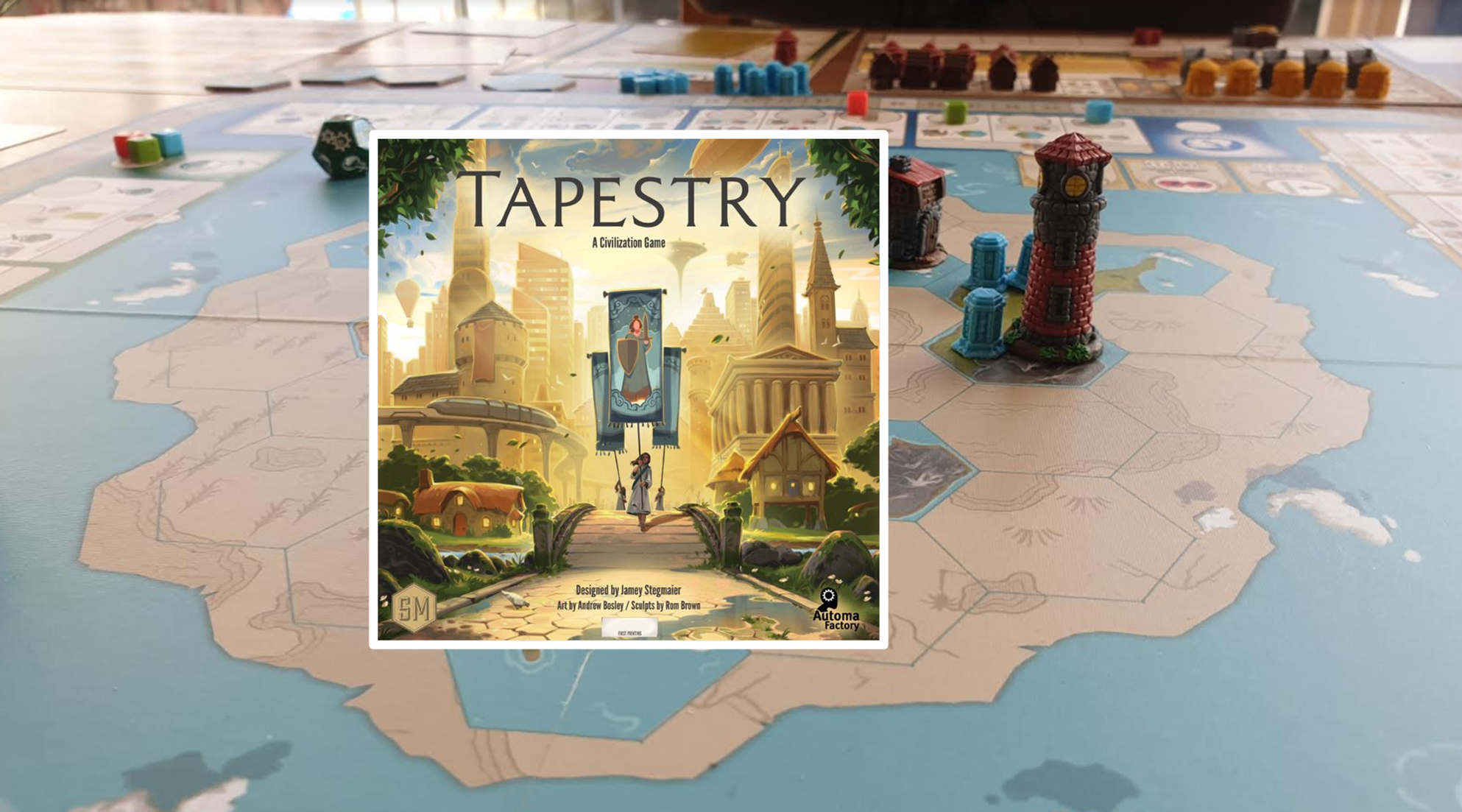Tapestry is the latest release from famed board game designer Jamey Stegmaier. Published by Stonemaier Games, Tapestry is a civilization style title, featuring variable player powers, tile placement, tech tracks and more. Playing in around 1.5 – 2 hours, the game sees 1 – 5 players advance their civilization along science, technology, exploration and military tracks. Each game players start afresh with the combination of civilization powers and Tapestry cards making each game feel unique. However, is this a game where you’ll want to keep playing again and again? Let’s find out!
Starting out each player randomly draws two civilizations, choosing one to keep, and a capital board – with players getting 2 capital boards to choose from in games of 2 – 3 players. On the main board players place two of their outposts onto the location matching the number on their capital, denoting their starting location. Players add one cube of their chosen colour to the start of the four advancement tracks and the score track. The landmarks are added to the associated board, with some placed to one side. Aside from reading over their civilization, the only other thing for players to do is add 5 buildings of each type to their player board.
There isn’t that much in the way of setup as a lot is handled via the income phase. This phase will be taken by players 5 times throughout the game, including their first and final turns. The exact stages of the phase differ depending on which income phase it is. For example resources aren’t earnt in the final income phase as it is mostly for point scoring. After the first income each time a player takes this type of turn they’d trigger any income phase civilization abilities.
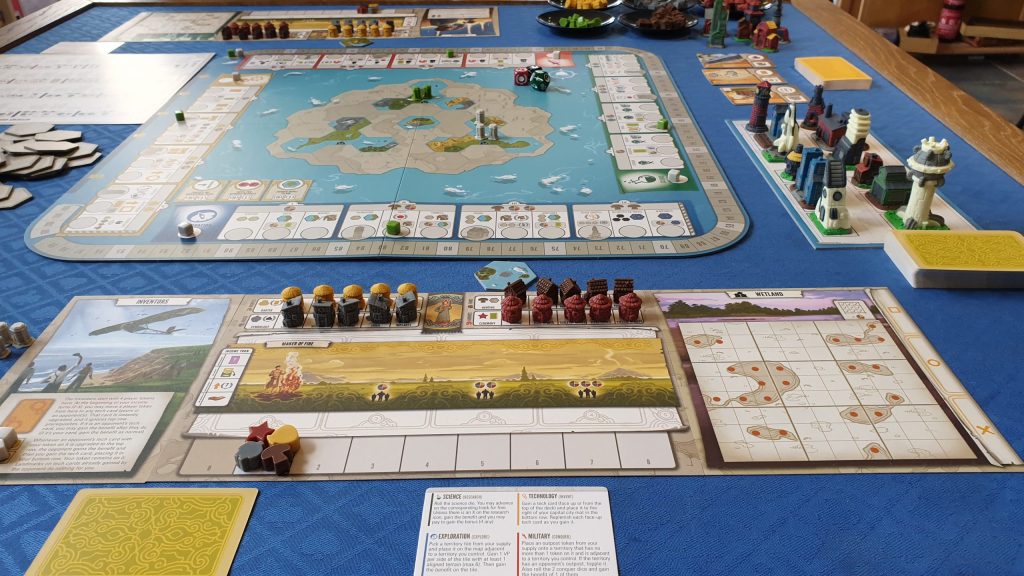
In the second to fourth income phases players will play a Tapestry card from their hand. If a player doesn’t have one they draw the top Tapestry card from the deck and place it face down on their player board – voiding the Tapestry benefit. Some of these offer instant “When Played” benefits, while others impact the players upcoming era – the advancement actions take before the next income phase.
After this a technology upgrade can be performed. The player can upgrade one of their lowest tier technology cards to the middle tier, receiving instant benefits. Instead, if the prerequisites are met, the player could upgrade a mid tier tech to the top level – naturally getting a bigger benefit. Players then score points via what is uncovered on their player board. This can be straight victory points, points for conquered territory and more.
The final stage of the income turn, and the order is important, is to gain resources. Based on what is uncovered on their income mat players gain gold, food, workers and culture. Tapestry cards and tiles to explore are also earnt this way. Whilst income is important the majority of Tapestry is played out in the advancement phase. When a player is in this phase, which they can choose to end on any turn they wish, they will simply be paying resources to move up one of the four tracks.
Technology as the name suggests is the player’s easiest route to inventing technology and hopefully reaping the rewards. Exploration sees the players gaining tiles or placing them onto the main board. This scores the players points based on the tile placement, with each tile also giving an instant bonus – ranging from a resource to a free technology card. Science is an odd track on it’s own as it revolves around rolling the science die. The track the die shows the player moves up for free, though may not always get the benefit for doing so.
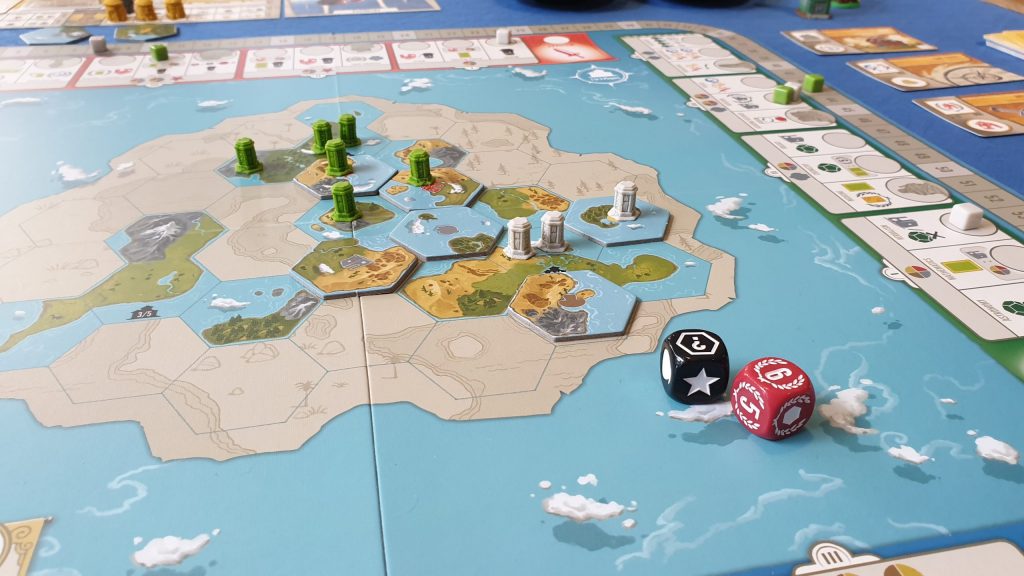
Military is all about expanding out across the map. Each time a player conquers a new location they roll the two military dice, choosing one of the two rewards – points or resources. Combat is almost not there, with players toppling the player piece of another player when taking a territory someone else controls. Note that a player cannot conquer a territory with two player pieces already in it, regardless of their owners. Therefore people cannot lose their capital as it starts with two outposts.
Getting into the next tier of an advancement track first awards the player a unique landmark, handily situated on the landmark board. These alongside the small buildings, which players can build via the advancement tracks, are added to the player’s capital board. These gridded boards come with filled spots, marked with red dots. Whenever one district of the grid (a 3×3 zone) is complete the player instantly gains 1 resource, with completed rows and columns scoring during the income phases.
The game plays out with players taking turns clockwise around the table. The key twist is that when one player chooses to perform their next, or even their final, income phase it doesn’t stop others from playing out their current era. This can mean one player has finished a few rounds before others. At the end of the game the player with the most points wins. There are a lot of points up for grabs, with some bonus points for things such as conquering the middle hexagon on the map. For reference, first game scores have seemingly been around 150 – 200, which are then beaten in most subsequent games.
Jamey Stegmaier, the designer, has already addressed rather publically some unbalanced elements of the game. An update to the original civilizations has been released accordingly, effectively nerfing some civilizations. For example, The Heralds start the game with -15 points! It is hard to speak of balance without many plays as each of the 16 civilizations. However, the points haven’t always been even remotely close.
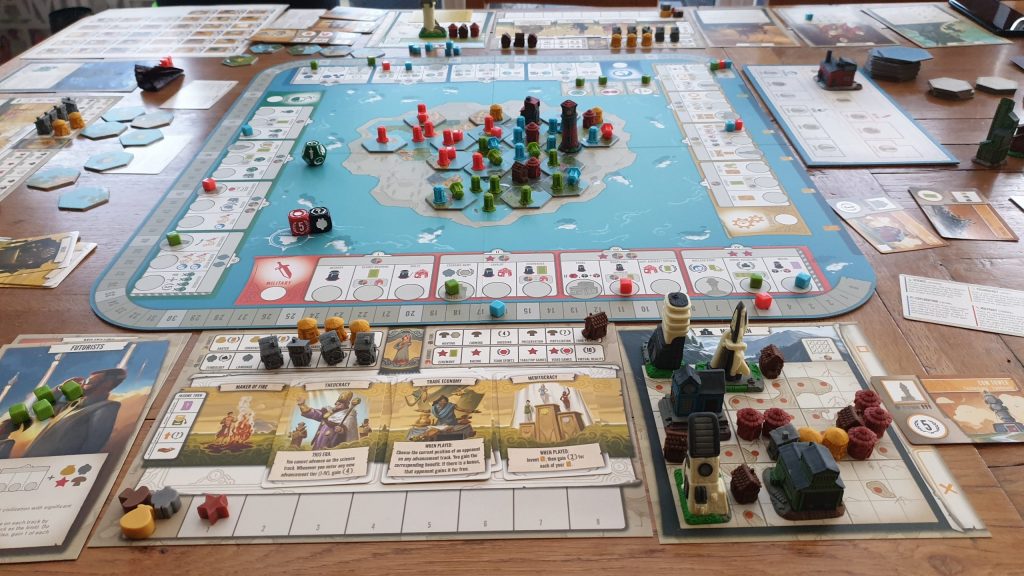
With so many civilizations there is an excitement going into each game of how to get the best out of their ability. Unlike the civilization abilities the tapestry cards come out during play, resulting in players having to react. This draws some of the strategic gameplay out of the experience, needing more of a tactical response from players to score big.
The constant between each game are the advancement tracks. Each offers something different for the civilization to flourish at. Players will have to struggle with wanting to do a bit of everything while simultaneously wanting to maximise the benefits from one track. The balancing of when to spend resources, or when to trigger the next income phase, is therefore an interesting trade off. It’s one that will come at different times each game – keeping the gameplay feeling fresh. The top of each track massively benefits the player in a different way, with it being almost impossible to reach the top of all in one game. This makes players want to try each track, wanting to play again to see the different journey.
For the most part the components are nothing less than stunning. The double sided main board is ideal for different player counts, helping the game be more than just playable. The artistic style of the game flows across each component, down to the Tapestry cards. There is a huge amount of iconography on the components, though the Tapestry cards break this completely being mostly text. One aspect of the player boards that is a little odd are the red dots on the capital boards. They just detract from the overall look when a rock symbol would have sufficed.
The landmarks are cute in style and this has caused a marmite-like response. To some they stand out and make the game more beautiful. Others note that the design of the landmarks are somewhat flawed, with them not aligning to the capital board they are meant to sit on. Simply including bases, or making the models sized to fit the grids of the capital boards, could have averted this. This is something not really forgivable for a game with such a high price tag. Especially as the game would have functionally worked with cardboard polyomino tiles for a more accessible price.
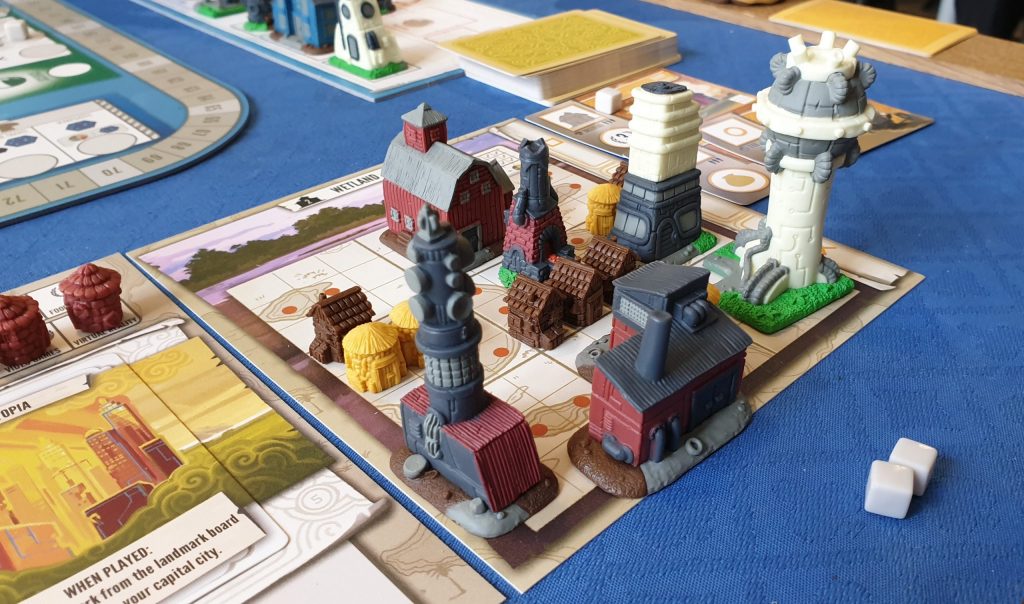
One of Tapesty’s selling points is supposed to be the incredibly short rulebook. Laid out across only 4 pages the rules show setup and explain the actions, yet it is done in an oversimplified way. As a result of condensing the rulebook there aren’t examples which could have made learning the game easier. There are so many symbols cheat sheets are included, listing every action and technology with what they mean. To exacerbate the learning issue only two of these helpful cheat sheets are included. This is fine in a two player game, where each player can constantly refer to their own sheet, yet Tapestry is for 2 – 5 players. This makes the first game much harder work than it needed to be, and any subsequent game with new players.
As awkward as the condensed rulebook is, once players get playing the cogs start to turn. By the end of their first game you can see players already working out how they could have done better. This drive to improve and the excitement of the different advancement tracks combines perfectly with the wide variety of civilizations. It makes players want to instantly jump back in and play another game – no mean feat for a 2 hour long experience.
In a similar vein to Stonemaier’s other titles, Tapestry feels like an efficiency puzzle where luck can impact your final outcome. In Viticulture there are the visitors, there are encounters in Scythe and now the cards of Tapestry. If you’ve played one of these titles you’ll know if this style is something you find fun or if it puts you off the puzzle. It might not be a true civilization style experience but Tapestry is one where you can grow a race, exploit it’s benefits and have multiple routes to victory – earning it’s space on my gaming shelf!
(Editor’s Note: Tapestry was provided to us by Asmodee for the review. The game is currently available from local board game stores, find your local store here.)

